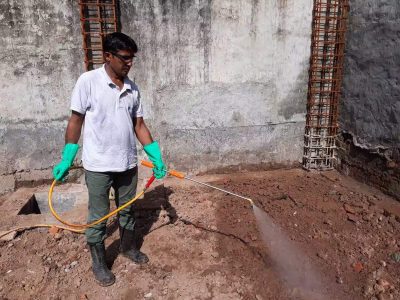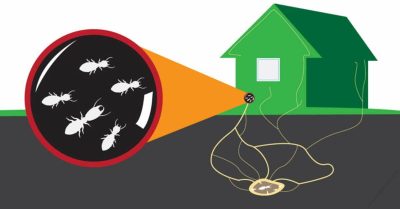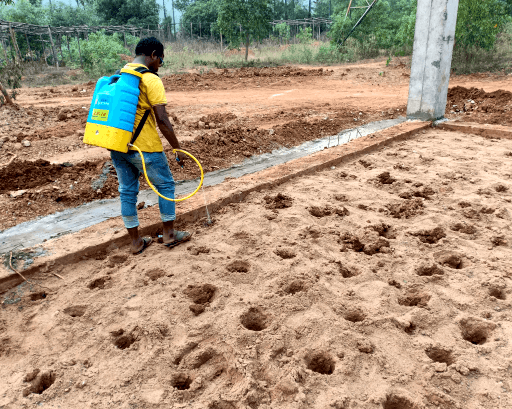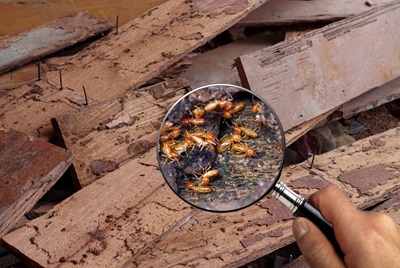Anti-Termite Treatment Cost In India
Termite infestations can wreak havoc on properties, causing structural damage and financial losses. In this comprehensive guide, we will delve into the factors influencing the cost of anti-termite treatments in India in 2024, providing valuable insights for homeowners and property managers.

Table of Contents
ToggleTermite Infestation: A Silent Menace in Indian Homes
Termite infestation poses a significant threat to the structural integrity of homes in India. These silent destroyers operate discreetly, often causing extensive damage before their presence becomes noticeable. In this section, we will explore the nuances of termite infestation, emphasizing the importance of understanding and addressing this issue promptly.
The Stealthy Nature of Termites
Unlike other pests that may make their presence known through visible signs, termites operate in stealth mode. They can infest a property for months or even years without leaving obvious clues. This silent invasion can lead to severe structural damage over time.
Importance of Anti-Termite Treatment
Recognizing the significance of anti-termite treatment is the first step in safeguarding your property. Termites feed on cellulose present in wood and other materials, making homes their primary target. Without intervention, termite infestations can compromise the structural stability of walls, floors, and even the foundation.
The High Cost of Ignoring Termites
Delayed action against termites can result in substantial financial losses. Repairing termite-induced damage is not only expensive but also time-consuming. Therefore, homeowners need to be proactive in addressing termite issues to avoid the hefty costs associated with structural repairs.
Why Understanding Anti-Termite Treatment Cost Matters
1. Size and Type of Property
Understanding the nuances of a property's size and type is paramount when deciphering the cost of anti-termite treatment. In this section, we'll delve into how these factors intricately influence the overall expense, providing homeowners with insights to make informed decisions.
Small vs. Large Properties
The size of a property plays a pivotal role in determining the extent of termite infestation and subsequently, the treatment cost. Larger properties provide more hiding spots for termites, and extensive areas may require more thorough treatment, increasing the overall expense. On the other hand, smaller properties may benefit from a more targeted approach, potentially reducing costs.
Residential vs. Commercial Properties
Distinguishing between residential and commercial properties is crucial in gauging termite treatment costs. Commercial spaces, with their diverse structures and functionalities, may demand specialized treatment methods, impacting the overall expense. Residential properties, while varied in size, often have a more straightforward treatment process, influencing costs differently.
Severity of Infestation
The severity of termite infestation directly correlates with the complexity of the treatment required. In this subsection, we'll explore how the extent of termite activity influences the overall cost, shedding light on why early detection is crucial.
Early Detection Saves Costs
Detecting termite infestations in their early stages can significantly reduce treatment costs. Minimal damage means less intensive measures are necessary, saving homeowners from potential extensive repairs. Regular inspections and vigilance contribute to early detection, emphasizing the importance of proactive termite management.
Advanced Infestations: Escalating Treatment Expenses
On the flip side, advanced termite infestations pose a greater challenge and often require more aggressive treatment methods. The extent of damage incurred may necessitate repairs in addition to termite control measures, contributing to higher overall costs. Homeowners facing advanced infestations should brace themselves for a more intricate and potentially expensive treatment process.

2. Treatment Method Chosen
The method chosen for anti-termite treatment is a critical determinant of the overall cost. Different techniques come with distinct price tags, and understanding these variances empowers homeowners to select the most effective and budget-friendly option.
Chemical Barriers: Balancing Effectiveness and Cost
Chemical barriers involve the application of termiticides to create a protective shield around the property. While highly effective, this method incurs material and labor costs. Homeowners opting for chemical barriers should weigh the benefits of long-term protection against the upfront investment required.
Bait Systems: A Strategic Approach
Bait systems lure termites away from the property, gradually eliminating the colony. Though generally cost-effective, their success relies on consistent monitoring and timely bait replenishment. Homeowners considering bait systems should factor in ongoing maintenance costs when evaluating the overall expense.
Fumigation: Comprehensive but Pricey
Fumigation, a tenting method that involves enclosing the entire structure and administering gas, is a comprehensive but expensive option. It ensures thorough eradication of termites but can be disruptive and may require temporary relocation. Homeowners should weigh the benefits against the higher cost and logistical challenges.
Heat Treatment: Eco-Friendly Innovation
Heat treatment involves raising the temperature within a structure to lethal levels for termites. While eco-friendly, it may be costlier due to specialized equipment requirements. Homeowners valuing environmental considerations may find this method worth the investment, balancing effectiveness with sustainability.
Common Anti-Termite Treatment Methods
Exploring Effective Strategies for Termite Control
In the quest to combat termite infestations, homeowners are faced with a plethora of treatment options. This section will comprehensively explore the most common anti-termite treatment methods available in 2024, shedding light on their efficacy, advantages, and potential drawbacks.
1. Chemical Barriers
Overview:
Chemical barriers involve the strategic application of termiticides around the property's perimeter, creating a protective barrier that termites cannot breach.
Efficacy:
Highly effective, chemical barriers provide long-lasting protection by eradicating termites upon contact. They are a popular choice for both preventive and curative treatments.
Advantages:
- Long-lasting protection.
- Effective against various termite species.
- Suitable for pre-construction and post-construction treatments.
Considerations:
- Initial investment for materials and professional application.
- May require periodic reapplication for sustained effectiveness.
2. Bait Systems
Overview:
Bait systems utilize baits strategically placed around the property to attract termites. Once consumed, the bait is shared within the colony, leading to its eradication.
Efficacy:
Effective in eliminating termite colonies, bait systems provide a targeted approach without requiring extensive chemical application.
Advantages:
- Environmentally friendly.
- Less intrusive than fumigation.
- Can be used as a preventive measure.
Considerations:
- Requires ongoing monitoring and bait replenishment.
- Effectiveness may vary based on termite species.
3. Fumigation
Overview:
Fumigation involves enclosing the entire structure in a tent and administering gas to eliminate termites. It is a comprehensive, all-encompassing treatment.
Efficacy:
Highly effective in eradicating termites throughout the structure, including hard-to-reach areas.
Advantages:
- Ensures complete termite elimination.
- Suitable for severe infestations.
- No residual chemicals left after treatment.
Considerations:
- Disruptive, requiring temporary relocation.
- Higher cost compared to other methods.
- Applicability may be limited based on property size.
4. Heat Treatment
Overview:
Heat treatment raises the temperature within a structure to levels lethal for termites, effectively eliminating the infestation.
Efficacy:
Environmentally friendly and highly effective, heat treatment penetrates walls and inaccessible areas, ensuring thorough termite elimination.
Advantages:
- Minimal chemical usage.
- Eco-friendly option.
- Can treat large and complex structures effectively.
Considerations:
- Requires specialized equipment.
- Higher upfront cost.
- May necessitate temporary evacuation during treatment.
Understanding these common anti-termite treatment methods is crucial for homeowners navigating the landscape of termite control.

Cost Breakdown for Anti-Termite Treatments
Understanding the Components of Anti-Termite Treatment Costs
Embarking on the journey to protect your home from termite infestations involves not only choosing the right treatment method but also understanding the breakdown of associated costs. In this section, we will dissect the components contributing to the overall expense of anti-termite treatments, providing homeowners with a transparent view of their investment.
1. Initial Inspection Fees
Before any treatment begins, a thorough inspection is conducted to assess the extent of termite infestation. This crucial step helps determine the most appropriate treatment method. Inspection fees cover the expertise of professionals and the use of specialized tools to identify the presence and severity of termites.
Tips for Cost Management:
- Obtain quotes from multiple inspection services for comparison.
- Consider bundled packages that include inspection and treatment services.
2. Material Costs
The materials used in anti-termite treatments contribute significantly to the overall cost. Whether it's termiticides for chemical barriers, bait stations for bait systems, or fumigants for tenting, these materials are essential for effective termite control.
Tips for Cost Management:
- Inquire about the types and brands of materials being used.
- Explore eco-friendly options that may have a slightly higher upfront cost but offer long-term benefits.
3. Labor Charges
Professional expertise is paramount in ensuring the success of anti-termite treatments. Labor charges encompass the wages of trained technicians who apply the chosen treatment method. The complexity of the treatment, the size of the property, and the severity of the infestation influence labor costs.
Tips for Cost Management:
- Request a detailed breakdown of labor charges.
- Inquire about the experience and certifications of the technicians.
4. Follow-up Inspections
Post-treatment inspections are crucial to ensuring the effectiveness of the chosen method and identifying any signs of termite resurgence. Follow-up inspections may incur additional fees but are instrumental in maintaining long-term protection.
Tips for Cost Management:
- Clarify the frequency and cost of follow-up inspections.
- Inquire about warranties or guarantees offered by the treatment service.
Understanding the cost breakdown allows homeowners to make informed decisions aligned with their budget and property's specific needs. In the subsequent sections, we will explore regional variances in anti-termite treatment costs, providing insights into why different areas may have varying expenses.
Anti-Termite Treatment Cost in India 2024: Understanding the Expenses
In the battle against termites, one of the critical aspects that homeowners face is the cost of anti-termite treatments. Understanding these expenses is crucial for making informed decisions and safeguarding your home from these silent invaders. In India, the cost of anti-termite treatment can vary based on factors such as the type of treatment, property size, and location. Let's delve into the specifics of the cost associated with pre-construction and post-construction termite treatments in 2024.
1. Pre-Construction Termite Treatment Cost
For those planning to construct a new property, pre-construction termite treatment is a proactive measure to prevent termite infestations from the very beginning. The cost of pre-construction termite treatment in India typically varies between Rs 8 to Rs 10 per square foot.
Factors Influencing Pre-Construction Treatment Cost:
Property Size: Larger properties will naturally incur higher costs due to the increased area that needs to be treated.
Type of Treatment: Different pre-construction treatments may have varying costs based on the materials and methods used.
Location: The geographical location can influence the prevalence of termites, impacting the type of treatment required and, consequently, the overall cost.

2. Post-Construction Termite Treatment Cost
For existing structures or properties, post-construction termite treatment is essential to address and eliminate termite infestations. The cost of post-construction termite treatment in India depends on the level of termite infestation.
Factors Influencing Post-Construction Treatment Cost:
Severity of Infestation: The extent of termite infestation will impact the complexity of the treatment required, influencing the overall cost.
Property Size: Larger properties may have higher costs for post-construction treatment due to the increased area that needs to be covered.
Treatment Method: Different treatment methods, such as DRILL-FILL-SEAL, may have varied costs.
3. Specific Cost for a 1BHK Property
For a 1BHK (One Bedroom, Hall, Kitchen) property, the cost of anti-termite treatment in India typically ranges between Rs 1200 to Rs 1500. This cost provides a baseline for homeowners with smaller living spaces, offering a targeted solution for termite prevention or elimination.
Factors Influencing 1BHK Treatment Cost:
Treatment Type: The chosen treatment method will impact the cost, with some methods being more cost-effective for smaller spaces.
Professional Service: Engaging professional services may incur additional charges but ensures expertise and thorough treatment.
Understanding the specific costs associated with anti-termite treatments empowers homeowners to budget effectively and choose the most suitable treatment for their property. Whether it's safeguarding a new construction or addressing existing termite issues, investing in anti-termite treatments is a proactive step toward protecting the longevity and integrity of your home.

DIY vs. Professional Anti-Termite Treatment
Pros and Cons of Do-It-Yourself and Professional Approaches
As homeowners grapple with the decision of how to address termite infestations, the choice between DIY (Do-It-Yourself) and professional treatments looms large. This section will explore the advantages and disadvantages of each approach, providing valuable insights to help you make an informed decision based on your preferences, expertise, and the unique characteristics of your property.
1. DIY Anti-Termite Treatment
Pros:
Cost Savings: DIY treatments are often more budget-friendly, with homeowners purchasing their chosen products and applying them without professional assistance.
Immediate Action: DIY options allow homeowners to address termite concerns promptly without waiting for a scheduled appointment with a professional service.
Flexibility: Homeowners have the flexibility to choose specific products or methods they feel comfortable using, tailoring the treatment to their preferences.
Cons:
Limited Effectiveness: DIY treatments may lack the precision and potency of professional-grade solutions, potentially leading to incomplete eradication of termite colonies.
Risk of Misapplication: Inexperienced application of chemicals or treatments may result in ineffective results or, in some cases, pose risks to residents and pets.
Lack of Warranty: DIY treatments typically do not come with the same level of guarantee or warranty as professional services, leaving homeowners responsible for any ongoing issues.
2. Professional Anti-Termite Treatment
Pros:
Expertise and Training: Professional pest control services bring specialized knowledge and training, ensuring a comprehensive understanding of termite behavior and effective treatment methods.
Guaranteed Results: Many professional services offer warranties or guarantees, promising continued support and additional treatments if termite activity persists.
Efficiency: Professionals can assess the extent of infestation accurately and apply treatments with precision, maximizing effectiveness.
Cons:
Higher Cost: Professional services typically come with a higher upfront cost, including inspection fees, material costs, and labor charges.
Scheduling Constraints: Homeowners may need to align with the availability of professional services, potentially leading to delays in treatment.
Chemical Exposure Concerns: Some individuals may have concerns about the use of chemicals in professional treatments, particularly if they have sensitivities or environmental considerations.
Making the Decision
The decision between DIY and professional anti-termite treatments ultimately depends on various factors, including the severity of the infestation, budget constraints, and personal comfort with applying treatments.
Recommendation: For extensive infestations or when dealing with structural concerns, professional services are often the safer and more effective choice. DIY options may be suitable for early detection or minor infestations, but careful consideration of the potential risks and benefits is crucial.
Importance of Timely Anti-Termite Treatment
Safeguarding Your Investment through Proactive Management
In the battle against termites, timing is everything. This section emphasizes the critical importance of timely anti-termite treatment, shedding light on how swift action can prevent extensive damage, preserve your property, and ultimately save you from substantial financial burdens.
1. Preventing Structural Damage
Termite infestations, if left unchecked, have the potential to cause significant structural damage to your home. Termites feed on cellulose found in wood, weakening its structural integrity over time. Timely treatment is a proactive measure to halt this process, preventing the deterioration of essential components like walls, floors, and even the foundation.
Signs of Termite Activity:
- Hollow-sounding wood.
- Discarded wings near windows or doors.
- Mud tubes along exterior walls.
- Visible tunnels in wooden structures.
2. Long-Term Cost Savings
While the upfront cost of anti-termite treatment may seem daunting, it pales in comparison to the potential expenses associated with repairing termite-induced damage. Acting promptly can save you from the financial burden of extensive repairs and reconstruction.
Financial Considerations:
- Repairing termite damage involves not only material costs but also labor charges.
- The longer termite activity persists, the more extensive the damage becomes, leading to higher repair costs.
3. Preserving Home Value
Your home is a significant investment, and its value is closely tied to its structural soundness. Timely anti-termite treatment ensures the preservation of your property's value by preventing the degradation of key structural elements. A well-maintained and termite-free home maintains its market appeal and resale value.
Real Estate Impact:
- A termite-free home is more attractive to potential buyers.
- Termite damage can significantly reduce the market value of a property.
4. Avoiding Escalating Treatment Costs
Delaying anti-termite treatment may lead to more extensive infestations, requiring more complex and costly treatment methods. Swift action at the first signs of termite activity allows for less invasive and more budget-friendly treatment options.
Treatment Progression:
- Early detection allows for localized and targeted treatments.
- Advanced infestations may necessitate comprehensive and more expensive methods like fumigation.
Embracing Proactive Termite Management
In conclusion, the importance of timely anti-termite treatment cannot be overstated. Proactive management not only prevents structural damage but also contributes to long-term cost savings and the preservation of your property's value. Stay vigilant, address termite concerns promptly, and consider anti-termite treatment as a strategic investment in the longevity and integrity of your home.
Choosing the Right Professional Service
Key Considerations for Selecting Your Termite Control Partner
Selecting the right professional service for termite control is a crucial step in ensuring effective and lasting results. In this section, we'll guide you through the essential considerations to make an informed decision, from researching potential services to obtaining multiple quotes for comparison.
1. Researching Termite Control Services
Key Steps:
Online Reviews: Explore reviews and testimonials from previous customers. Platforms like Yelp, Google Reviews, or specialized pest control review websites can offer valuable insights.
Local Recommendations: Seek recommendations from neighbors, friends, or local community forums. Personal experiences provide valuable information about the reliability of a service.
Certifications and Licenses: Ensure that the chosen service holds the necessary certifications and licenses. Certified technicians are more likely to have the expertise required for effective termite control.
2. Obtaining Multiple Quotes for Comparison
Factors to Consider:
Scope of Treatment: Different services may recommend varying approaches based on the severity of infestation and the size of the property. Ensure that quotes align with your specific needs.
Cost Breakdown: Request a detailed breakdown of costs, including inspection fees, material costs, labor charges, and any additional fees. This transparency helps you understand where your investment is going.
Warranty or Guarantee: Inquire about the warranty or guarantee offered by the service. A commitment to return for follow-up treatments if necessary indicates the service's confidence in its effectiveness.
3. Experience and Expertise
Questions to Ask:
Years in Business: An established termite control service with a track record of successful treatments is likely to be more reliable.
Technician Training: Inquire about the training and certifications of the technicians. A well-trained team is better equipped to handle diverse termite infestations.
Treatment Methods: Understand the range of treatment methods offered. A service that provides various options can tailor the approach to your specific needs.
4. Customer Service and Communication
Indicators of Quality Service:
Responsiveness: A service that responds promptly to inquiries and concerns demonstrates a commitment to customer satisfaction.
Communication: Clear communication about the treatment plan, expected outcomes, and any necessary preparations on your part is essential for a successful partnership.
Professionalism: Professional conduct, from initial contact to the completion of treatments, is indicative of a service's dedication to quality.
Making an Informed Decision
Choosing the right professional termite control service is a critical step in safeguarding your home. By researching thoroughly, obtaining multiple quotes, considering experience and expertise, and evaluating customer service, you can make an informed decision that aligns with your priorities and ensures effective termite management.
Environmental Impact of Anti-Termite Treatments
Eco-Friendly Options for Termite Control
As environmental awareness grows, homeowners are increasingly seeking termite control methods that balance effectiveness with minimal impact on the environment. In this section, we'll explore eco-friendly options, highlighting their benefits and considerations for homeowners looking to adopt sustainable termite control practices.
1. Bait Systems
Eco-Friendly Characteristics:
Limited Chemical Usage: Bait systems use minimal amounts of chemicals, reducing the overall environmental impact.
Targeted Application: Bait stations are strategically placed, minimizing the dispersion of chemicals in the environment.
Considerations:
Monitoring Requirements: Regular monitoring and bait replenishment are necessary, requiring ongoing attention.
Effectiveness: While effective, bait systems may take time to eliminate the entire termite colony.
2. Heat Treatment
Eco-Friendly Characteristics:
Chemical-Free: Heat treatment relies on raising the temperature within the structure, eliminating the need for chemical pesticides.
Localized Impact: The treatment is confined to the targeted area, minimizing environmental dispersion.
Considerations:
Specialized Equipment: Heat treatment requires specialized equipment, potentially increasing the upfront environmental footprint.
Energy Consumption: The process involves raising the temperature, which may contribute to increased energy consumption.
3. Choosing Low-Toxicity Chemical Barriers
Eco-Friendly Characteristics:
Low Environmental Impact: Opting for termiticides with low toxicity minimizes the environmental impact.
Long-Term Effectiveness: Low-toxicity chemicals can provide long-lasting protection without compromising effectiveness.
Considerations:
Initial Application: While low-toxicity, the initial application may still involve the use of chemical barriers.
Professional Application: Professional expertise is crucial to ensure correct and safe application.
4. Eco-Friendly Practices for DIY Prevention
Eco-Friendly Characteristics:
Natural Repellents: Some homeowners explore natural repellents like neem oil or boric acid for DIY prevention.
Reduced Chemical Reliance: By using natural substances, the reliance on synthetic chemicals is minimized.
Considerations:
Effectiveness: Natural repellents may not be as potent as chemical treatments, requiring consistent and vigilant application.
DIY Monitoring: Homeowners adopting eco-friendly DIY methods should actively monitor for signs of termite activity.
Striking a Balance
While complete avoidance of chemicals may be challenging in termite control, homeowners can adopt practices that minimize environmental impact. Choosing eco-friendly options and understanding their considerations allows you to strike a balance between effective termite management and environmental consciousness.
Practical Tips for Cost-Effective Termite Prevention
Proactive Measures to Safeguard Your Home
Preventing termite infestations is a cost-effective and proactive approach to safeguarding your home. In this section, we'll explore practical tips that homeowners can implement to minimize the risk of termite activity, addressing key areas such as regular inspections, moisture control, and the use of termite-resistant materials.
1. Regular Inspections
Frequency:
- Annually: Schedule professional termite inspections at least once a year.
Benefits:
Early Detection: Regular inspections facilitate the early detection of termite activity, allowing for timely intervention.
Preventive Measures: Professionals can recommend preventive measures based on the specific needs of your property.
2. Addressing Moisture Issues
Key Areas to Monitor:
Crawl Spaces: Ensure proper ventilation and address any moisture accumulation.
Leaky Pipes: Promptly repair any leaks in plumbing or roofing to prevent moisture buildup.
Benefits:
Termite Deterrence: Termites are attracted to moisture; addressing water issues makes your home less appealing to them.
Preventing Mold: Moisture control also helps prevent mold growth, contributing to overall home health.
3. Using Termite-Resistant Materials
Materials to Consider:
Pressure-Treated Wood: Treated wood is infused with chemicals that deter termite infestations.
Concrete and Metal: These materials are naturally resistant to termite activity.
Benefits:
Long-Term Protection: Using termite-resistant materials provides a lasting barrier against infestations.
Reduced Maintenance: Termite-resistant materials may require less maintenance compared to traditional wood.
4. Maintaining Landscaping Practices
Guidelines:
Keep Plants Away: Avoid placing shrubs or plants directly against the exterior walls of your home.
Regular Pruning: Trim branches and foliage regularly to reduce potential termite pathways.
Benefits:
Reduced Access: Pruned vegetation and well-maintained landscaping minimize opportunities for termites to access your home.
Improved Ventilation: Adequate airflow around the structure helps maintain a dry environment, deterring termite activity.
5. Sealing Entry Points
Common Entry Points:
Cracks in Foundation: Seal any cracks or gaps in the foundation.
Gaps Around Windows and Doors: Ensure proper sealing to prevent termite entry.
Benefits:
Preventive Barrier: Sealing entry points creates a barrier, making it more challenging for termites to infiltrate your home.
Energy Efficiency: Proper sealing not only deters termites but also contributes to energy efficiency by minimizing drafts.
Empowering Homeowners for Termite Prevention
Implementing these practical tips empowers homeowners to take proactive measures in termite prevention. By integrating these strategies into your regular home maintenance routine, you create a robust defense against potential termite infestations, saving both time and money in the long run.
In the final sections, we will conclude our comprehensive guide with a summary of key takeaways, followed by a set of unique FAQs addressing common concerns about anti-termite treatments. Stay tuned for a concise recap and valuable insights into navigating the world of termite control in India.
Key Takeaways: Navigating the World of Termite Control in India
In our comprehensive guide on termite control in India, we've covered a range of topics, from understanding the cost factors influencing treatments to exploring eco-friendly options and practical tips for prevention. As we conclude, let's recap the key takeaways to empower homeowners in navigating the world of termite control effectively.
1. Timely Action is Crucial
Recognizing the signs of termite activity and acting promptly is essential to prevent structural damage and avoid escalating treatment costs. Early detection through regular inspections is a proactive strategy for homeowners.
2. Choosing the Right Professional Service Matters
Researching termite control services, obtaining multiple quotes, and considering factors like experience and expertise are critical steps in selecting a reliable and effective termite control partner.
3. Balancing Effectiveness with Eco-Friendly Practices
Homeowners can strike a balance between effective termite control and environmental consciousness by choosing eco-friendly options such as bait systems, heat treatment, and low-toxicity chemical barriers.
4. Proactive Prevention is Cost-Effective
Implementing practical tips, including regular inspections, moisture control, the use of termite-resistant materials, and landscaping practices, can prevent termite infestations and save homeowners from potential expenses.
5. Sealing Entry Points and Proper Ventilation
Creating a physical barrier by sealing entry points and maintaining proper ventilation helps deter termites. Termite-resistant materials and landscaping practices contribute to a holistic approach to termite prevention.
FAQs: Addressing Common Concerns
Now, let's address some common concerns through a set of unique FAQs, providing additional insights into the world of termite control.
Q: Can I apply anti-termite treatments on my own, or should I always hire a professional?
A: While some DIY options exist, professional services bring expertise, specialized equipment, and the assurance of warranties or guarantees. The choice depends on the severity of the infestation and individual comfort levels.
Q: Are eco-friendly termite control methods as effective as chemical treatments?
A: Eco-friendly methods, such as bait systems and heat treatment, can be highly effective. However, their success may depend on factors like termite species and the extent of infestation. Consult with professionals to determine the most suitable option.
Q: How often should I schedule termite inspections for my home?
A: Annual termite inspections are recommended, but more frequent checks may be necessary in areas with high termite activity or for properties with a history of infestations.
Q: Are termite-resistant materials expensive?
A: While initial costs may be slightly higher, termite-resistant materials often result in long-term cost savings due to reduced maintenance and the prevention of termite-induced damage.
Q: Can I prevent termites without using chemicals?
A: Yes, by adopting practices such as proper moisture control, regular inspections, landscaping strategies, and the use of termite-resistant materials, homeowners can significantly reduce the risk of termite infestations without heavy reliance on chemicals.
Conclusion: Safeguarding Your Home Against Termites
In conclusion, proactive and informed homeowners can effectively navigate the world of termite control in India. From understanding treatment costs to choosing eco-friendly options and implementing preventive measures, taking the right steps can ensure the longevity and integrity of your home. Stay vigilant, act promptly, and embrace a holistic approach to termite prevention for a termite-free living space.
Other Termite Related Topics You May Be Interested In
- Bayer Premise: How To Use? Termiticide For Termite Control
- Anti-Termite Treatment Cost In India [2024]
- What if house failed termite inspection?
- What is WDO inspection - Wood destroying organism inspection
- Lethal TC: Chlorpyriphos 20% EC – The Ultimate Termite Terminator
- What Is Termite Treatment? Types & Methods
- What Do Flying Termites Look Like?
- What Causes Termites? Root Causes of Termite Infestation

